Perform the test in accordance with the message.
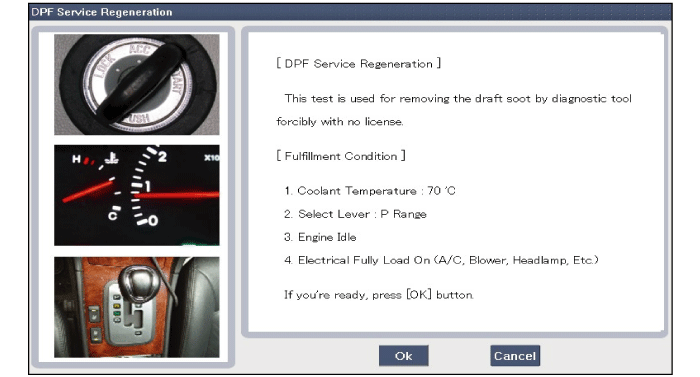
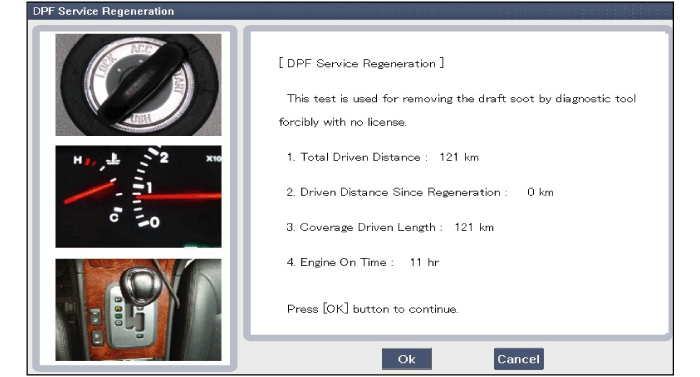
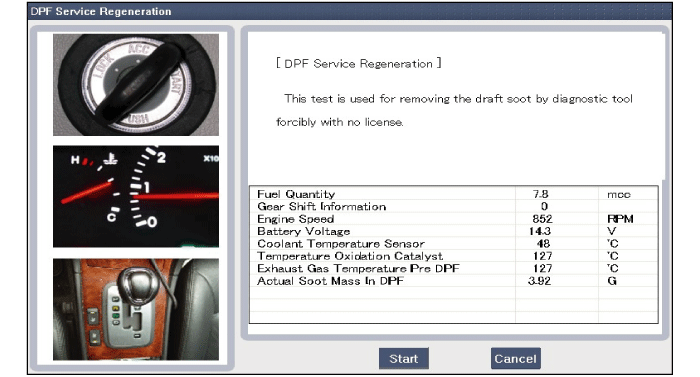
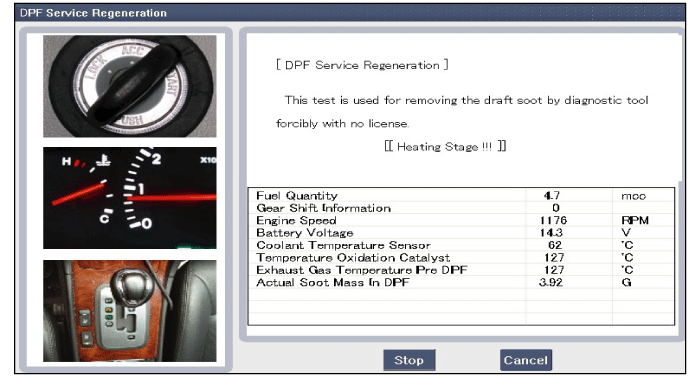
If the fulfillment condition is not satisfied, DPF regeneration test will fail.
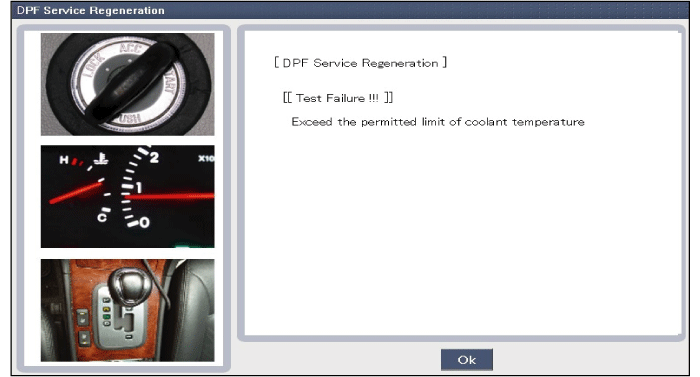
This procedures is to forcibly regenerate the DPF with scan tool when the DPF doesn't have been regenerated during driving. For example, if the vehicle has repeated "Low speed driving" or "Short distance driving", the DPF regeneration procedure cannot be proceeded because "Regeneration Mode" doesn't made.
If performing the DPF service regeneration mode indoors, fire or burn injuries may occur by high-temperature exhaust gas.
Therefore the DPF service regeneration mode must be performed in a outdoor safe zone.
Engine coolant temperature: about 70℃
Engine at idle
P-range (A/T) or Neutral (M/T)
Normal battery voltage
Electrical fully load ON (A/C ON if equipped, Blower ON with maximum speed, Head Lamp ON, Wiper ON, Other Lamps ON, etc.)
The air conditioner's electrical load is very high. Accordingly, to make regeneration mode more quickly, turn it ON (If eqquipped).
Turn ignition switch OFF.
Connect a GDS to Data Link Connector (DLC).
Start engine at idle and P-range (A/T) or neutral (M/T).
Apply electrical fully load to the vehicle (A/C ON, Blower ON with maximum speed, Head Lamp ON, Wiper ON, and Other Lamps ON, etc.)
Select "Vehicle, Model year, Engine, System".
Select "Vehicle S/W Management".
Select "DPF Service Regeneration".
Perform the test in accordance with the message.




If the fulfillment condition is not satisfied, DPF regeneration test will fail.

Must check damage of the DPF assembly before removing the DPF assembly.
Remove the exhaust pipe of the DPF end side. Check damage or decoloration(white) of the rear section of the DPF.
Check existence of the soot of the rear section of the DPF. DPS assembly has some trouble if you find black soot.
Turn the ignition switch OFF and disconnect the battery negative (-) terminal.
Remove the under cover.
(Refer to Engine and transaxle assembly in this group)
Remove the alternater.
(Refer to Engine Electrical System - "Alternator")
Disconnect the wiring connectors and harness clamps and remove the wiring protector around the exhaust manifold.

Disconnect the wiring mounting bracket (A).

Remove the exhaust manifold heat protector (A).
Tightening torque :
14.7 ~ 19.6 N.m (1.5 ~ 2.0 kgf.m, 10.8 ~ 14.5 lb-ft)

Remove the EGR pipe (A).
Tightening torque
Bolt (B) : 21.6 ~ 27.5N.m (2.2 ~ 2.8kgf.m, 15.9 ~ 20.3lb-ft)
Bolt (C) : 29.4 ~ 34.3N.m (3.0 ~ 3.5kgf.m, 21.7 ~ 25.3lb-ft)


Remove the front muffler (A).
Tightening torque :
39.2 ~ 58.9 N.m (4.0 ~ 6.0 kgf.m, 28.9 ~ 43.4 lb-ft)

Remove the catalytic converter brackets (A).
Tightening torque :
49.0 ~ 63.7 N.m (5.0 ~ 6.5 kgf.m, 36.2 ~ 47.0 lb-ft)



Remove the catalytic converter (A).
Tightening torque :
49.0 ~ 63.7 N.m (5.0 ~ 6.5 kgf.m, 36.2 ~ 47.0 lb-ft)


Installation is reverse of removal.
After replacing the Converter , MUST perform the "Component Change Routine" procedure. Otherwise trouble related with engine performance or emission control may occur until ECM learning about the component is over.
Turn the ignition switch OFF.
Connect the GDS to Data Link Connector (DLC).
Turn ignition switch ON.
Select "Vehicle, Model year, Engine, System".
Select "Vehicle S/W Management".
Select "Component Change Routine".
Select "Converter Change".

Turn the ignition switch OFF and Turn the ignition switch ON again in 20 seconds.

After replacing the DPF assembly, MUST perform the "Component Change Routine" procedure. Otherwise trouble related with engine performance or emission control may occur until ECM learning about the component is over.
Turn the ignition switch OFF.
Connect the GDS to Data Link Connector (DLC).
Turn the ignition switch ON.
Select "Vehicle, Model year, Engine, System".
Select "Vehicle S/W Management".
Select "Component Change Routine".
Select "DPF Change".

Turn the ignition switch OFF and Turn the ignition switch ON again in 20 seconds.
